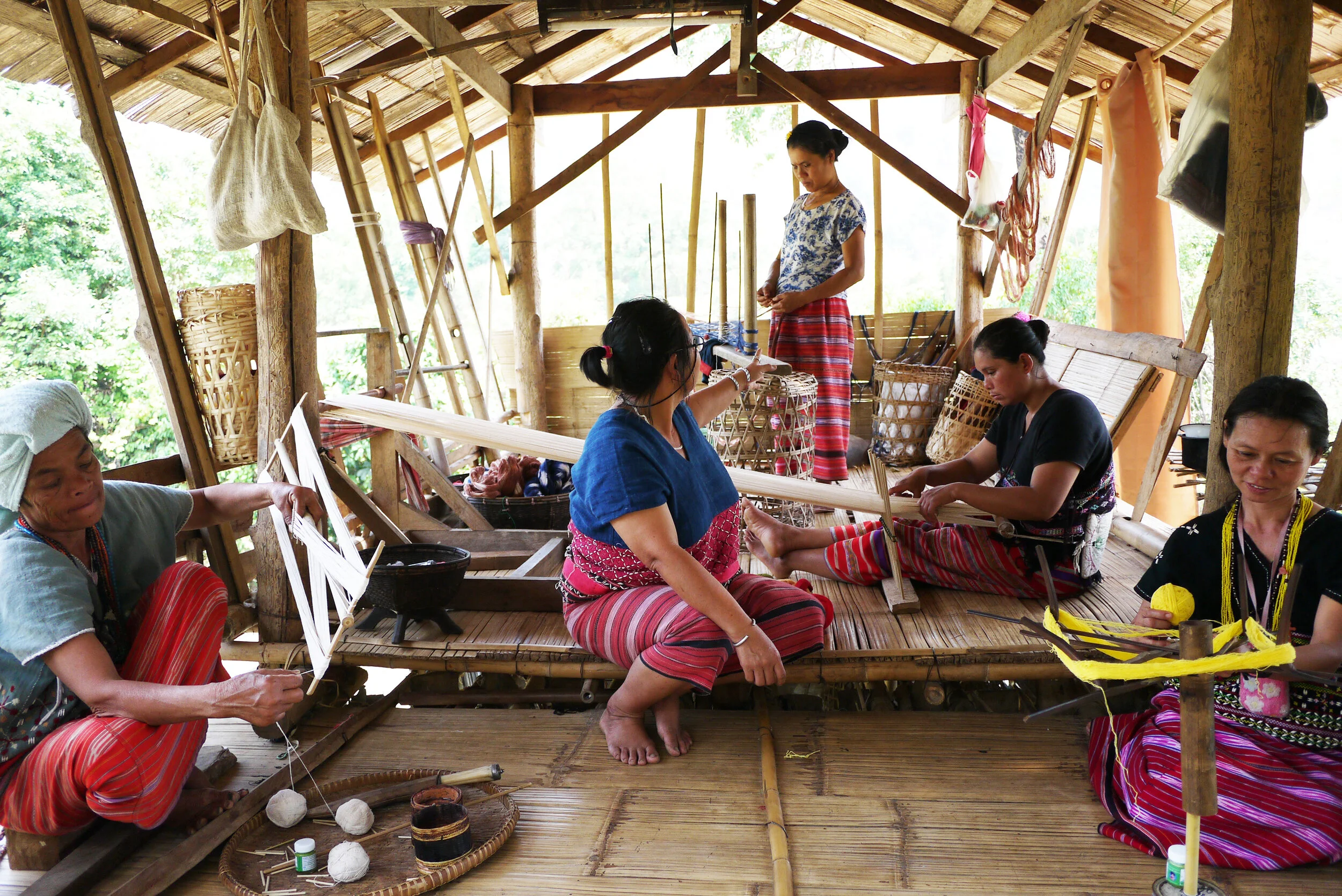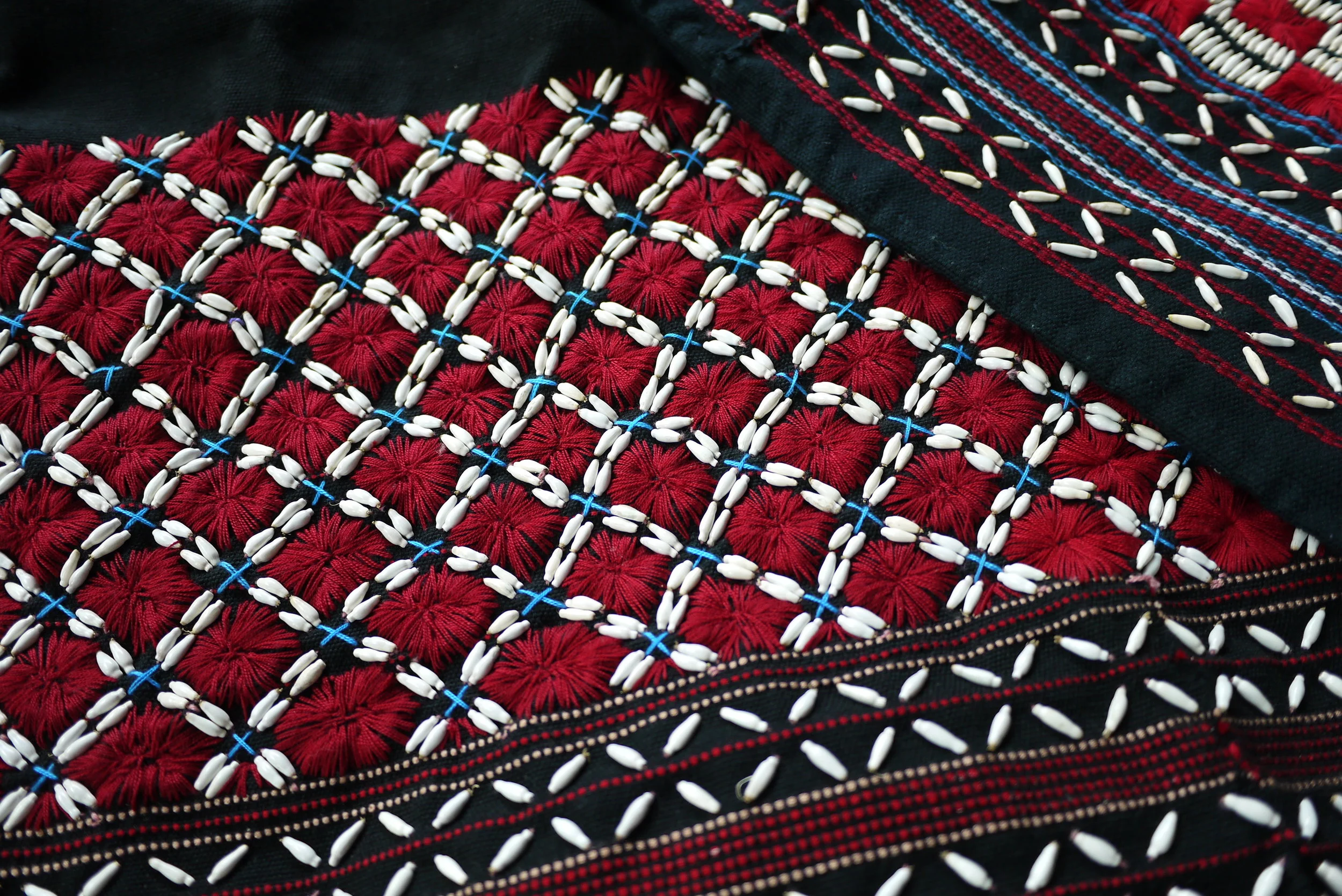Karen Textiles in Northern Thailand
Originally from Myanmar, the Karen is an ethnic group with several different languages and cultural customs. They are often divided into 3 main sub-groups known as the White Karen (Sgaw), the Red Karen (Karenni), and the Black Karen (Pao). The sub-groups may also be called after their spoken languages (e.g. Pwo Karen). Often, the image of the Karen ethnic group is strongly associated with the “long-neck” Karen (also known as Padaung), creating confusion about the cultural identity of the umbrella group.
Karen is an anglicized version of the word Kayin, itself referring to Kayan State in Myanmar. The term was introduced during modern times through the influence of the colonial British empire and Western missionaries who built schools in Karen villages and converted some of the local communities to Christianity. Despite this Western influence, the Karen traditional dress remains well embedded in everyday life, and villagers continue to produce textiles for their daily use but also as a source of additional income by selling at street markets and even producing for high-end boutiques and hotels.
A field surrounding the weavers’ working space in Mae Chaem. In the future, the women would like to grow and harvest their own cotton to produce their textiles. Photo by Sali Sasaki.
A wooden house in a Karen village in Mae Takri, Doi Saket District, Chiang Mai Province. Photo by Sali Sasaki.
Textiles products for sale at a Karen microenterprise in Mae Chaem district, Chiang Mai Province, Thailand. Photo by Sali Sasaki.
In the past, the Karen people sustained their way of life as forest communities, playing a key role in environmental conservation with principles linked to their core beliefs. In northern Thailand, they often shared forest areas with the Tai people with whom they collectively maintained and replanted trees, relying strongly on each other in daily life. The Karen lost ownership of their forest land when the spaces were reclaimed by the Thai National Government and turned into national parks for tourism purposes.
It is important to mention that the Karen group’s background is one of survival and conflict with the central Myanmar government. For many decades, this situation has generated a flow of migration at the porous Thai-Myanmar border. Many Karen people live as unregistered refugees in Thailand with a string of politicized issues attached, including the absence of recognition of their indigenous culture within the country. As the Karen seek their independence, their textiles are not integrated into either Thai or Burmese textile culture.
This may explain the limited literature about Karen textiles and the difficulty in finding collections in local museums and institutions. To experience Karen culture and textiles, one has to go directly to the communities, visit dedicated boutiques or go to street markets. Over the years, Chiang Mai has progressively become a commercial hub for the Karen. For instance, Warorot Market in the city centre and the refined boutique Sop Moei are two very different contexts where one can purchase Pwo Karen products.
Weavers working at a Karen micro enterprise in Mae Chaem district, Chiang Mai Province, Thailand. Photo by Sali Sasaki.
Cotton bags on display in a Karen village at Mae Takri National Park, Doi Saket District, Chiang Mai Province. Photo by Sali Sasaki.
There are distinctive features found in Karen textiles and garments. Their form, such as the V-neck tunics and tube skirt’s simple designs, their traditional use of colour including red, black, and white (a specific colour for unmarried women), and textures with the embroidered seed adornments on thick cotton or hemp fabrics. Through the limited number of designs, Karen textiles have managed a particular visual identity that can easily be recognized by markets and shops.
Detail of an embroidered tunic that uses the Karen’s signature palette of black, red and white. Photo by Sali Sasaki.
Many Karen women are micro-entrepreneurs and continue their traditional weaving in various districts of Chiang Mai Province, working with a backstrap loom on the floor. Some of them harvest their own cotton and hand-spin the threads. The use of chemical dyes has become ubiquitous these days and as a consequence the limited palette of the past expanded to a multitude of colours to boost consumer appeal. The Karen in northern Thailand commonly practices ikat weaving, which is a distinctive feature of their red tube skirts with stripe motifs. Some textile experts qualify the Karen textiles as being “rudimentary” because of the use of thick cotton threads and the lack of fine and intricate patterns. However, the raw characteristics of their textiles reflect a modern sense of aesthetics that coincidentally responds well to the demand of local urban youth. Today, it is common to see trendy young Thais walk around with their Karen V-neck tunics at art and design events. While the future of traditional Karen textiles remains fragile, this may open up a new door for local women and their communities.
A weaver working on her house balcony, with a backstrap loom in Mae Takri, Doi Saket District, Chiang Mai Province. Photo by Sali Sasaki.
Detail of a red tube skirt which is typically worn by the Karen women. Photo by Sali Sasaki.
Detail of an embroidered tunic using local fruit seeds as ornaments. This community in Doi Saket has re-introduced the use of natural dyes in recent years through the support of a training programme. Photo by Sali Sasaki.
















